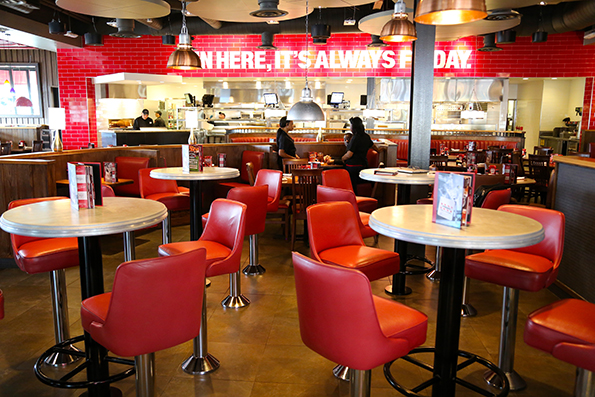TGI Fridays is sporting a new look and a fresh approach to franchising under its private-equity ownership.
Since longtime TGI Fridays parent Carlson closed on the 900-unit brand’s sale this summer to private-equity firms Sentinel Capital Partners and TriArtisan Capital Partners, the company has announced several refranchising deals, with more expected.
Fridays also unveiled a new unit in Addison, Texas, in September that extends the contemporary motifs launched earlier this year in Nashville, Tenn., and Brooklyn, N.Y.
Between these changes and several operational initiatives now in motion, Nick Shepherd, Fridays’ president and chief executive, said he is confident the Carrollton, Texas-based brand is well positioned in the competitive casual-dining segment.
“We’re in a strong position now to have a cadre of well-financed, purposeful franchisees who understand how Fridays works,” Shepherd said during a recent lunch interview.
Hear more from Shepherd about Fridays >>
Under Carlson, Fridays’ 535 domestic units were about half company-owned and half franchised. But under the new ownership, refranchising has clearly taken center stage.
The most recent refranchising deal was Elk Grove, Calif.-based MarLu Investment Group’s agreement to buy 22 TGI Fridays restaurants in Colorado and Texas. As part of that deal, MarLu agreed to the brand’s reimaging plan. Shepherd said Fridays units in South Florida and Central Florida are likely to be next in the refranchising push.
Fridays is also extending that effort to the international United Kingdom market, where it has 66 restaurants. The brand was a pioneer in taking U.S. casual-dining brands abroad, opening in the United Kingdom in 1986.

Mark Kalinoswki, an analyst at Janney Capital Markets, said in a recent note that, “in general, Fridays works well internationally because patrons view it as the quintessential American experience.”
Kalinowski noted that Chicago-based consultancy Technomic ranked Fridays as the No. 1 full-service varied-menu brand in international 2013 system sales. Fridays’ international system sales for 2013 were $995 million, compared with $361 million for Applebee’s Neighborhood Grill & Bar and $343.6 million for Chili’s Grill & Bar.
In 2013 domestic sales, Nation’s Restaurant News’ most recent Top 100 survey ranked Fridays at No. 34, with $1.8 billion in its U.S. system of 527 units. Applebee’s was No. 10, with $4.5 billion, and Chili’s was No. 16, with $3.5 billion in domestic systemwide sales.
Fridays currently is in 62 markets abroad, Shepherd said. “There is an aspiration not to be American, but have the freedom and choice that comes with being American,” he said.
To accommodate a growing franchise base, Shepherd said it was “critically important” that the company maintain close communication with its franchisees and keep a talent-management and talent-development strategy in place.
“You have to have the right tools to allow franchisees to win with that talent,” he said. “We need to make sure our tools are the best in the marketplace.”
Renewed emphasis on the bar, service
(Continued from page 1)
Staffing has become increasingly important to the Fridays brand, Shepherd said. New and remodeled units have more prominent bars, he said, which serve as a focal centerpiece for the restaurant, with differentiated seating, televisions and a colorful display of liquor bottles. Shepherd said “the bar [is] critical to the vibe of the Fridays.”
With the renewed emphasis on the bar option, staff members are trained to seat guests where they will feel most comfortable, he said.
“We spent our time reading the guest to figure out whether they wanted to be where the action is or do they want to be farther away from the bar,” he said.
“Over the years — some of it to do with logistics, some of it to do with positioning — we sort of forgot about that bar heritage. It’s such an incredible part of the brand’s DNA,” he said. That is now the cornerstone of menu and staff training.

And rather than returning to the brand’s roots as the quintessential “fern bar” of the 1970s, Fridays is now emphasizing craft cocktails, featuring higher end liquor brands and placing a premium on bartenders’ skills, highlighted each year with its “World Bartender Championship.”
Fridays has also worked on its service model, which Shepherd said should neither be too formal nor too personal.
“The word we use to describe it is engagement,” Shepherd said. “Do we engage our guests in the appropriate way?”
That varies for each guest, he said. “You have to ask questions so you can put the guest in the best place to have fun,” he said. Fridays’ training now includes a lot of role-playing exercises, he said, in addition to more traditional computer-based instruction.
The company’s staff recruitment tools also include questions to find personality traits in potential employees that align with the Fridays brand, he said.
Fridays has relaxed its rules that limited body piercings and tattoos. “Between 30 and 40 percent of under-30-year-olds have a body piercing or tattoo,” Shepherd said. “We can’t say all of those folks can’t work at a Fridays. … They probably have the characteristics we are looking for in our servers.”
Managers are given more time to spend on the floor and to interact with guests as well, Shepherd said.
“We needed to figure out how our team members engaged with the guests,” Shepherd said. “It was one-size-fits-all. We’d almost become a caricature of ourselves. We’re on a journey here. We’ve not declared a victory on any single element of what we’ve done. Our guest service scores show our service has become much more personal.”
In the meantime, Shepherd said he continues to measure each proposed business initiative on what he calls the “Three Simple Questions:” Is it right for the guest? Can the brand make money doing this? Can the brand execute it?
“You have to ask them in that order,” Shepherd said. “Some people will ask that second question first. … but the guest will notice.”
Contact Ron Ruggless at [email protected].
Follow him on Twitter: @RonRuggless





